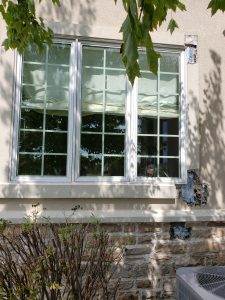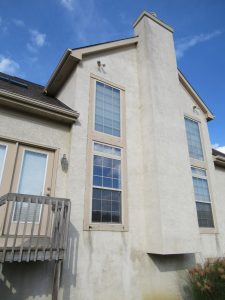There is no doubt that stucco provides a beautiful durable alternative to traditional siding. When installed properly, stucco provides a weather resistant, long lasting and high-quality surface that doesn’t rot, rust, or burn. It really does sound like the best choice.While newer Exterior Insulation Finish Systems (EIFS), when installed correctly, have a built-in drainage system, older systems are creating a big problem across the United States for homeowners.Older EIFS systems have created moisture and rotting issues in many homes. Unfortunately, when not installed correctly, it can and most likely will cause highly expensive repairs, down the road. The picture above shows test spots that we performed that has wall rot inside of the walls. As you can see, the wall with the Tyvek sheathing has formed to the stucco and caused no gap between the two to allow water to flow through. Therefore, the wood surrounding this area is taking in the moisture that has nowhere to go.
The picture above shows test spots that we performed that has wall rot inside of the walls. As you can see, the wall with the Tyvek sheathing has formed to the stucco and caused no gap between the two to allow water to flow through. Therefore, the wood surrounding this area is taking in the moisture that has nowhere to go. If you look around the window and on top of the chimney, you can see the discoloration on the side of the exterior wall. Also note the general discolored appearance under the windows and chimney. Once you can see this damage, it means the inside wall structure may be compromised. The dark spots can be mildew showing through the wall and may indicate mold growing on the inside. A leading area of concern for water seepage is improper flashing installation around the home’s windows.WRBS is just a combination of the correct installation of the entire system from membrane layer to flashing and weep screed, walls, doors, and trim.If you or anyone you know comes across wall rot in your home, or to learn more, contact Thompson Building Associates, and we can assist you with a consultation and remediation of the issue.Remember, letting the problem continue through the years will cause the problem to grow and become more expensive as the rot progresses.Follow us on Social Media!Facebook YouTube Instagram
If you look around the window and on top of the chimney, you can see the discoloration on the side of the exterior wall. Also note the general discolored appearance under the windows and chimney. Once you can see this damage, it means the inside wall structure may be compromised. The dark spots can be mildew showing through the wall and may indicate mold growing on the inside. A leading area of concern for water seepage is improper flashing installation around the home’s windows.WRBS is just a combination of the correct installation of the entire system from membrane layer to flashing and weep screed, walls, doors, and trim.If you or anyone you know comes across wall rot in your home, or to learn more, contact Thompson Building Associates, and we can assist you with a consultation and remediation of the issue.Remember, letting the problem continue through the years will cause the problem to grow and become more expensive as the rot progresses.Follow us on Social Media!Facebook YouTube Instagram
What is EIFS?
New EIFS systems have six layers, unlike earlier applications:- An optional water-resistant barrier
- Adhesive
- Foam insulation
- Base coat
- Reinforcement mesh
- Finish
What is exterior wall rot?
Water trapped behind any siding cladding can cause mold, but it can also cause the building materials behind the stucco to rot. Wall rot can be harder than mold to diagnose as there may not be any signs of visible water damage.Please note that porous cladding like stucco, EIFS, stone, brick and faux products are much more likely to allow water to penetrate the cladding, enter the wall, and cause deterioration.Wood rot is a very serious issue that can lead to massive structural damage to your home. While it is possible for some stucco damage to be repaired, severe wood rot could require completely removing a wall’s exterior to be able to replace the rotten wood. This repair can create a repair cost on thousands of dollars and more often than not – will often not be covered under your home’s insurance policy.Wall rot does not come from the same underlying cause. That is why we need to distinguish the cause of what created the condition in the first place. The wall rot we are focusing on is water intrusion through the stucco, stone, and brick veneer cladding.The recent flurry of the failure of Water-Resistant Barrier Systems (WRBS) started coming to light as companies were having to go into homes and remove the exterior wall cladding from homes. The damage done by the trapped water can cost homeowner’s a 5-6 figure expenses (this was true in about 650 homes that were estimated for water intrusion damage.) The stucco or stone placed on homes is to give the house a more elegant feel. That being said, without the proper WRBS in place, the home can turn into a massive headache.What is Wall Rot Caused by Water Intrusion?
It is the disintegration of the external walls of a home. In stucco homes this is the result of water seeping behind the stucco without a means to escape. The water becomes trapped between the WRBS and stucco or even worse between the WRBS and the wall sheathing. One study states, that about 95% of homes with wall rot can be traced back to the stucco and house wrap bonding together. When installing stucco, there should always be a ventilation gap or rain screen gap to ensure the problem does not happen. If the home is not using a well-designed WRBS, the water will seep through stucco or stone cladding, causing the structure to become water-logged. Stucco soaks up water like a sponge after all!As mentioned, stucco is not the only place we see wall rot occur. Manufactured stone veneers can also have problems with wall rot. The first layer of stone veneer is similar to stucco, and the stone placed as the last layer. Therefore, if the rock begins to sag, crack, or you see discoloration in the grout lines, it could be wall rot. That means the procedures need to be the same when laying that first layer of stucco. Otherwise, they will run into the same problems as homes with only exterior stucco walls.What Does Moisture Damage Behind Stucco Look Like?
 The picture above shows test spots that we performed that has wall rot inside of the walls. As you can see, the wall with the Tyvek sheathing has formed to the stucco and caused no gap between the two to allow water to flow through. Therefore, the wood surrounding this area is taking in the moisture that has nowhere to go.
The picture above shows test spots that we performed that has wall rot inside of the walls. As you can see, the wall with the Tyvek sheathing has formed to the stucco and caused no gap between the two to allow water to flow through. Therefore, the wood surrounding this area is taking in the moisture that has nowhere to go. If you look around the window and on top of the chimney, you can see the discoloration on the side of the exterior wall. Also note the general discolored appearance under the windows and chimney. Once you can see this damage, it means the inside wall structure may be compromised. The dark spots can be mildew showing through the wall and may indicate mold growing on the inside. A leading area of concern for water seepage is improper flashing installation around the home’s windows.WRBS is just a combination of the correct installation of the entire system from membrane layer to flashing and weep screed, walls, doors, and trim.If you or anyone you know comes across wall rot in your home, or to learn more, contact Thompson Building Associates, and we can assist you with a consultation and remediation of the issue.Remember, letting the problem continue through the years will cause the problem to grow and become more expensive as the rot progresses.Follow us on Social Media!Facebook YouTube Instagram
If you look around the window and on top of the chimney, you can see the discoloration on the side of the exterior wall. Also note the general discolored appearance under the windows and chimney. Once you can see this damage, it means the inside wall structure may be compromised. The dark spots can be mildew showing through the wall and may indicate mold growing on the inside. A leading area of concern for water seepage is improper flashing installation around the home’s windows.WRBS is just a combination of the correct installation of the entire system from membrane layer to flashing and weep screed, walls, doors, and trim.If you or anyone you know comes across wall rot in your home, or to learn more, contact Thompson Building Associates, and we can assist you with a consultation and remediation of the issue.Remember, letting the problem continue through the years will cause the problem to grow and become more expensive as the rot progresses.Follow us on Social Media!Facebook YouTube Instagram 